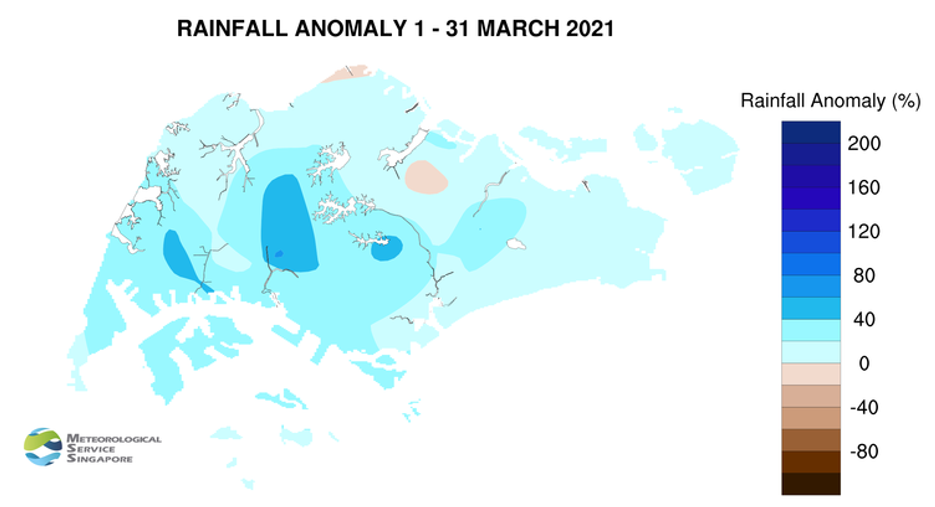Fortnightly Weather Outlook for 1 – 15 April 2021
Singapore, 1 April 2021 – The Northeast Monsoon conditions that have been prevailing over the region since December 2020 are expected to gradually weaken and end with the onset of inter-monsoon conditions in the first half of April 2021. The prevailing low-level winds over the equatorial Southeast Asia region including Singapore are forecast to become variable in direction and are expected to persist through May 2021.
2 During the inter-monsoon period, warm weather and thundery showers in the afternoon and early evening are common. The prevailing light winds coupled with strong day-time heating of land areas are conducive for the development of localised and intense thunderstorms. During the inter-monsoon months, the incidence of lightning activity is higher than other times of the year.
3 In the first fortnight of April 2021, the monsoon rain band is forecast to lie close to the equatorial Southeast Asia region. Short-duration moderate to heavy thundery showers with frequent lightning are expected over parts of the island in the afternoon on most days. On a few of these days, with strong convergence of winds in the surrounding vicinity, the thundery showers could extend into the early evening.
4 Also in the coming fortnight, the prevailing winds are forecast to shift to blow from the west on a few days. The eastward passage of a Sumatra squall from the Strait of Malacca could bring thundery showers with gusty winds over Singapore on one or two mornings. In addition, on one or two days in the fortnight, it is expected to be fair and warm arising from stable atmospheric conditions over Singapore and the surrounding vicinity. Overall, the rainfall for the first fortnight of April 2021 is expected to be near normal over most parts of the island.
5 Climatologically, April is one of the warmest months of the year. On most days in the first half of April 2021, the daily temperature is forecast to range between 25°C and 34°C. On a few days, the daily maximum temperature could reach a high of around 35°C.
6 For updates of the daily weather forecast, please visit our MSS website (https://www.weather.gov.sg), NEA website (www.nea.gov.sg), or download the myENV app, or the MSS’ Weather@SG app.
REVIEW (1 – 31 March 2021)
7 In March 2021, the dry phase of the Northeast Monsoon prevailed over Singapore and the surrounding region, and the low-level winds blew generally from the north or northeast.
8 Compared to the first fortnight of March 2021 where there were several days of dry and warm conditions, the second fortnight of March 2021 was wet with thundery showers in the afternoon on many days, mostly over the western half of the island. The wet weather was due to strong day-time heating of land areas coupled with convergence of winds either over Singapore or the surrounding vicinity. On 23 March 2021, thundery showers fell over many areas of the island, and was particularly intense over the western half of Singapore. The daily total rainfall recorded that day was 151.5mm at Jurong West. This was the highest daily total rainfall recorded in March 2021.
9 Compared to the second half of March 2021, the first half of the month was generally warmer with more days recording maximum temperatures of 34°C or more. The highest daily maximum temperature of 35.6°C was recorded at Tengah on 2 March 2021. At the Changi climate station, the mean monthly temperature of 27.9°C for March 2021 was 0.4°C higher than the month’s long-term average.
10 Almost all parts of the island recorded average to slightly above average rainfall in March 2021. The highest anomaly of 66% above average was recorded at Ulu Pandan. The anomaly at Ang Mo Kio was 16% below average.

CLIMATE STATION STATISTICS
Long-term Statistics for April
(Climatological reference period: 1981 – 2010)
| Average daily maximum temperature |
32.3 °C |
| Average daily minimum temperature |
25.0 °C |
| Average monthly temperature |
28.0 °C |
| Average rainfall |
154.8 mm |
| Average number of rain days |
14 |
Historical Extremes for April
(Rainfall since 1869 and temperature since 1929)
| Highest monthly mean daily maximum temperature: |
33.9 °C (1983) |
| Lowest monthly mean daily minimum temperature: |
23.1 °C (1934) |
| Highest monthly rainfall ever recorded: |
454.9 mm (1900) |
| Lowest monthly rainfall ever recorded: |
16.6 mm (1977) |